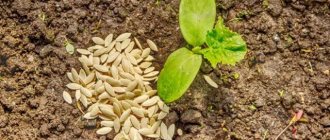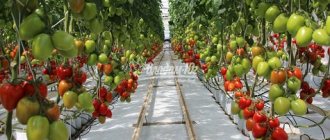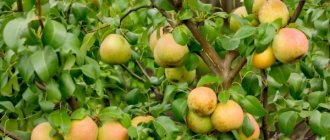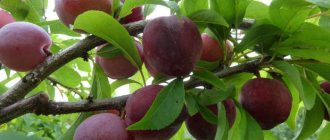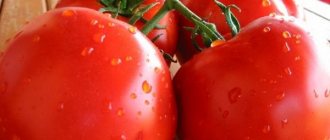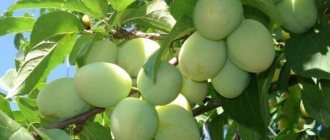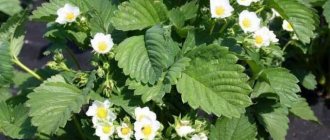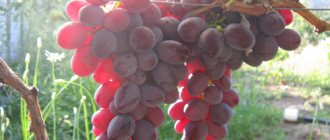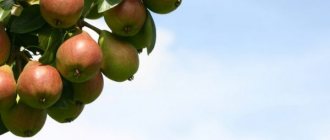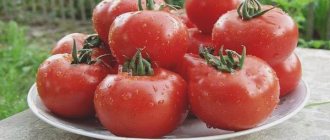Characteristics and description of the variety
Cucumber Cedric is a first generation hybrid, so a mark must be indicated immediately after the name.
Cedric F1 appeared thanks to the work of Dutch breeders, employees. This is an early ripening hybrid that allows you to get an early fruit harvest.
The cucumber hybrid does not have male flowers; all the flowers on the plant are female, with an ovary already present.
Cucumber grows without the need for any pollination or fertilization, a phenomenon called parthenocarpy.
The fruits contain only a few dozen thin, hollow seeds that are not capable of reproduction.
Pollination by bees or bumblebees is even undesirable for Cedric F1, since it may result in rough fruits containing full-fledged seeds.
Features of the bush and fruits
This cucumber hybrid has a powerful stem, leaves are large, soft, rough on both sides of the leaf blade, and green. The main crop of the plant grows on lateral stems located on both sides of the central stem. The branching of the hybrid is average, the bush is indeterminate, that is, not limited in growth, so it will grow as long as the vegetable grower allows it or until sub-zero temperatures set in.
Important! The gardener must remember that the usefulness of seeds collected from hybrids is apparent; the next generation of vegetables obtained from them will be of different sizes, and the plant yield will be weak.
The fruits of the hybrid Cedric F1 are small, dark green, with whitish indistinct stripes, and covered with pimples. The diameter of the fruit does not exceed 3–3.5 cm, the length of the greens varies from 12 to 14 cm. The pulp of the fruit is dense, without voids, crisp, and genetically has no bitterness. The average weight of greens is from 100 to 110 g.
Cucumbers are suitable for eating fresh and are also used for pickling and pickling.
Fruitfulness
The productivity of the Cedric F1 hybrid is very high precisely thanks to the bunched ovary. Each bunch develops from 2 to 4 cucumbers. From 1 m², a vegetable grower can harvest up to 16 kg of hybrid fruits, naturally, while observing all the subtleties of agricultural technology. The originators recommend growing 3–3.5 Cedric F1 plants per 1 m² of soil.
Did you know? The ancient Roman emperor Tiberius demanded fresh cucumbers at his table every day, throughout the year. For this reason, palace gardeners invented mobile greenhouses for cucumbers, which were taken out into the sun during the day and brought indoors by servants in the evening.
Ripening and flowering dates
The first flowers appear on the plant after about 30 days of cultivation. In greenhouses, flowering and fruiting of cucumber plants occurs several weeks earlier than in open ground.
Maturation in a bunch is not simultaneous, but sequential, one after another. The first cucumbers ripen 38–45 days after sprouts emerge from the ground. No more than 5 fruits ripen on the bush at the same time.
"Cedric F1": biological description, history
The new development of the agricultural company Enza Zaden Beheer BV, registered in the Netherlands, was included in the State Register of Breeding Achievements of the Russian Federation not so long ago - in 2015. In a short period of time, the cucumber has earned recognition among vegetable growers in all regions, as well as in Belarus, Moldova and Ukraine. Parthenocarpic is recommended for cultivation in protected soil throughout the year.
Bushes
The hybrid is represented by medium-branched plants with a powerful root system. The latter provides the vegetable with a larger feeding area. Shoots are indeterminate, strong. Medium-sized green leaf plates are attached to them using petioles. The type of flowering is predominantly female. Each node blooms 2-3 inflorescences that do not require pollination by insects.
Fruit
When the cucumber enters the fruiting phase, they begin to collect greens. At technical ripeness, their length is 12-14 cm, and their weight is 105 g. Zelentsy are painted in a dark green color, which is “diluted” by lighter short stripes. The thin skin is covered with small tubercles topped with white spines. The pulp is juicy and sweet with a characteristic crunch and aroma.
Pros and cons
- Hybrid Cedric F1 has undoubted advantages:
- big harvest;
- early fruiting;
- tasty and high-quality fruits;
- bunch fruiting;
- good taste of greens;
- lack of bitterness;
- resistance to stressful temperatures;
- immunity to certain diseases (cladosporiosis, cucumber mosaic virus and powdery mildew).
- Disadvantages of the variety:
- the high cost of seeds and the impossibility of independently collecting planting material;
- mandatory bush formation.
Video: experience of growing Serdrik cucumber in the Volgograd region
Advantages and disadvantages
The Cedric f1 cucumber has not only visual appeal, but also a large number of advantages:
- powerful and well-developed root system;
- bunched ovaries;
- possibility of year-round cultivation;
- obtaining very early vegetable products;
- high quality and excellent presentation of greens;
- stable and high productivity;
- stress resistance, temperature changes and insufficient lighting do not have a negative impact on growth, development and productivity;
- intensive yield of the crop throughout the entire fruiting period;
- the average yield of the hybrid form is at least 18-22 kg per square meter of cucumber beds.
The disadvantages include the rather high cost of planting material.
Sowing and growing technology
It is best to start growing cucumbers when spring temperatures have established themselves and remain quite high even at night. At this time, during the day the temperature should not fall below +20°C, and at night - below +15°C. It is even better to grow cucumbers in a place where the temperature is constantly in the range of +20...+22°C. It is advisable to start growing seedlings 3-4 weeks before the time comes for planting in a permanent place.
Read more about when to sow cucumbers for seedlings.
Growing cucumber seedlings:
- It is best to use planting pots with a diameter of 12 cm. The pots should have a hole in the bottom to drain excess moisture after watering. Also, each pot should be equipped with a fairly deep tray to protect window sills and seedling tables from moisture. Cucumbers do not tolerate disturbances to the root system, and react to this by stopping growth for up to 2 weeks. Therefore, it is advisable for a gardener to use cups made of organic matter (peat or humus) to grow cucumbers. This planting container decomposes well in the ground when placed, along with the plant, directly in moist soil.
- Soil for cucumber seedlings can be purchased from garden stores or mixed independently at home. For a homemade soil mixture, take equal parts: coarse sand, fertile soil and humus. You can also add several handfuls of wood ash sifted through a sieve, obtained from the wood of deciduous trees, to the soil mixture.
- The soil is poured into the planting pots to a little more than half the volume. Once the cucumbers begin to grow, soil will be gradually added by the grower directly below the root of the plant until it reaches the edge of the planting container. The soil in the pots is well moistened and allowed to warm up for several days at room temperature. When the temperature of the seeding soil warms up to +20°C, you can begin planting the seeds.
- Two planting holes with a depth of 1 to 1.5 cm are made in the soil of each container. Cucumber seeds are placed in the planting holes and covered with soil. After planting, water the soil very moderately. It is enough to moisten it slightly; there is no need to fill the soil so that the water flows through the drainage holes. Excess moisture can cause the seeds to rot. 7–10 days after germination, only the strongest plant is left in the pot. The excess seedling is not pulled out of the soil, but carefully cut off with scissors at the border of the soil.
- Pots with crops are placed in a warm place for 3-4 days. After the sprouts appear, the planting containers are transferred to a well-lit place (on a south window or under a special lamp).
- The main conditions for growing good seedlings are maintaining heat in the room and preventing dehydration of the plant. It is necessary to water cucumber seedlings not too often, but also to prevent the plants from withering. When watering, you need to carefully ensure that moisture does not fall on young plants, as this threatens the development of powdery mildew. Also, too much moisture at the root of the seedling can lead to the formation of a black leg, leading to the death of the cucumber. To prevent the evaporation of moisture from the soil ball, the pot with seedlings can be covered with a transparent plastic film. Thin cling film is perfect for this. It is also undesirable for the seedlings to be exposed to direct sunlight, so you can use newspaper to slightly shade the plants.
- When growing cucumbers, the room temperature should always be maintained at the same temperature so that the plants grow at a smooth rhythm. A sharp increase in temperature leads to rapid growth of the above-ground mass, elongation of the stem and leaves. Cold night temperatures stunt growth and weaken the plant, which then activates fungal spores and root rot.
- During the growing season of cucumbers in the room, the plants need hardening, adapting them to future planting in a permanent place. To harden the first weeks of life, it is enough to open the window for a period of 15 minutes to half an hour; later, when the temperature outside is not lower than room temperature, the plants are taken out into the open air. Outdoor hardening begins from 30 minutes and gradually, over time, is extended until full daylight hours.
- Cucumber seedlings remain in pots until the plants have formed 4-6 true leaves. Cucumber seedlings are supported vertically while growing in pots using special support pegs.
In the open ground
Cucumber seedlings or seeds can be planted in the ground when the soil warms up to at least +15°C. At this temperature, you can already consider planting, although the ideal soil temperature for cucumber is +18°C. But the air temperature, especially at night, should be quite high.
Cucumber seedlings are planted in open ground closer to June 1 to eliminate the possibility of returning night frosts. When planting, you need to avoid crowding in the garden bed, as the crop has large leaves. The sparser the plants are planted, the less likely it is for diseases to occur. Plants are planted together with a pot (made of peat, humus or paper).
Important! You can grow cucumbers at several times, for example, sow the first bed in mid-May, and the second in early July. This will allow you to harvest fruits until late autumn.
When replanting, you need to be careful to ensure that the soil does not come into contact with the plant stem. After planting, the bush is watered with warm water. The roots of a young plant should always be in warm, slightly moist soil.
Cucumbers need to be tied to a support. The simplest type of garter is a vertically attached cord. The cord is tied with a loose knot to the bottom of the plant and to a support wire located at a height of about 2 m. The cucumber stem is twisted around the cord weekly.
In open ground, plants are grown in a looser pattern than in a greenhouse. In a cucumber bed 60 cm wide, only 1 row of plants is grown. It is placed in the center along the bed. In this case, a distance between plants of 20 to 30 cm is maintained.
If the width of the bed exceeds 120 cm, you can grow 2 parallel rows of cucumbers on it. In this case, the distance in each row between plants is maintained from 20 to 30 cm, the cucumbers of the 1st row are located in relation to the cucumbers of the 2nd row in a zigzag (in a checkerboard pattern).
The checkerboard arrangement allows the plants to receive more light and better ventilation. For vegetative cucumbers, it is imperative to install support in the form of a longitudinal trellis up to 2 m high. A two-row planting of plants can be supported using a common trellis placed between these two rows.
We recommend that you familiarize yourself with how to grow cucumbers on a trellis in open ground.
Planting in a greenhouse
In central Russia, cucumber seedlings can be planted in an unheated greenhouse from May 1; in colder regions, it is better for the gardener to wait until May 15. At the same time, you can sow cucumber seeds, but plants grown through seedlings will develop more vigorously, produce a higher yield and suffer less from pests and diseases.
Since greenhouse space needs to be saved, cucumber bushes are grown in a greenhouse bed in a denser pattern than in open ground.
In a greenhouse, cucumbers are planted in both 1 and 2 rows, depending on the width of the greenhouse bed. When planted in 2 parallel rows, the bushes are arranged in a zigzag relative to the plants of the opposite row. The distance in the row between cucumbers is 10–15 cm.
To ensure that such a minimum distance does not create excessive planting density, the grower has to remove leaves from the plants. The lower 5-6 leaves are removed completely, so that 1 central stem remains.
In the future, the leaves will also be thinned out, but not so radically: out of 3 grown leaves, approximately 1 will be left on the stem. This will allow air to circulate freely between the plants in the greenhouse, and the cucumbers will also be fully illuminated, which is important for the setting and further development of fruits .
Find out how to make a greenhouse for cucumbers with your own hands.
Review of Cedric cucumbers - features of the variety
Plants » Vegetables » Cucumbers
13.05.2019729 0
Cucumber Cedric is an early-ripening parthenocarpic variety that does not need to be pollinated artificially or with the help of insects. It is an F1 hybrid, which makes it impossible to obtain seeds for planting at home. The variety is grown in different ways - in a greenhouse or open ground.
Cucumber seeds “Cedric”
Cedric cucumbers
Cedric has a high yield and cucumbers can be harvested for two months
General characteristics of cucumbers
Description of bushes:
- bush of indeterminate type (the central stem is not limited in growth);
- branching – average;
- flowering type – female;
- the root system is powerful;
- on the side there is an average number of stems;
- leaf color – rich green;
- the size of the leaf part is insignificant;
- 4-5 cucumbers are tied in one knot;
- The stems are not very pubescent.
Description of fruits:
- shape – cylindrical elongated;
- surface – smooth, medium-tubercular;
- ribbing is practically absent;
- there are white small spines;
- color – dark green;
- seeds – small;
- pulp – dense;
- the weight of one fruit is from 100 to 130 grams;
- the length of the greens is from 10 to 14 cm (at the gherkin stage - only 5 cm);
- used for pickling, canning, and preparing salads.
Cedric's fruits ripen gradually, so the harvest can be harvested within 2 months. If grown indoors or in a greenhouse, 2 turns are possible. For the cucumber to fully ripen, at least 35 days must pass.
The hybrid is characterized by abundant fruiting and increased productivity - per 1 sq. m accounts for 18-22 kg of fruit. Due to the localization of most of the cucumbers on the main stem, harvesting is greatly simplified.
Advantages and disadvantages
Advantages:
- the highest level of productivity;
- bunch type of ovary;
- power of the root system;
- the ability to grow year-round and in any conditions (in a greenhouse, in an open garden, on a windowsill);
- good presentation, transportability;
- stability of the harvest throughout the entire period;
- disease resistance;
- unpretentiousness (not afraid of temperature changes and lack of sunlight);
- lack of bitter taste;
- early ripeness;
- versatility of use;
- stress resistance.
Features of planting and care
The Cedric variety can be grown in 2 ways - seedlings and non-seedlings (seeds directly into the ground). In the second case, the main condition necessary is the absence of frost, well-warmed soil. The minimum temperature should be +13-15 degrees.
Peculiarities:
- If you plant seedlings initially, the yield increases and the ripening period decreases.
- When planting seedlings in greenhouse conditions, the seeds are sown in early April. When planting in the garden - in mid-May.
- It is not advisable to plant Cedric after growing zucchini, pumpkin, carrots, and beans on the plot. The best predecessors are lettuce and cabbage, green manure, and green peas.
- Cucumbers can be grown in one place for 4-5 years.
- The optimal temperature for cucumbers is from 20 to 22 degrees.
- The crop needs periodic feeding, loosening, and watering. Weeds and shoots must be removed. The side shoots are pinched, but the main stem does not need to be formed.
Planting seeds
Preparing and planting seeds and seedlings:
- Purchased seeds are prepared as follows: add 2 tbsp to 800 ml of water. l. table salt, stir thoroughly and place the seed material. Hollow elements float to the surface (they are thrown away).
- Next, the seed is placed in a weak solution of manganese for disinfection, which will prevent the development of diseases. Keep in liquid for 15-20 minutes, then rinse under running water and place on moistened gauze.
- Leave for a couple of days (during this time the seeds should sprout the first shoots).
- Moisten the soil substrate, lay out the seeds using the belt method, and sprinkle with soil.
- Cover the container with film.
- Maintain the temperature at 23-25 degrees.
- After the seedlings have formed, the film is removed and the temperature is reduced to +20 degrees.
- A week before the dive, take the box out to a cool place every day - initially for an hour, then the time increases. This contributes to the rapid adaptation of the plant after planting in other conditions.
- The seedling material is transplanted into a greenhouse or open soil after the formation of 4 leaves.
How and when to plant cucumber seedlings is described in more detail here.
Transfer
After transplanting into the ground, the cucumbers are covered with film material for the first 7-10 days at night. Picking rules:
- The soil is pre-fertilized with minerals. The fertilizer should contain phosphorus, zinc and iron elements. Peat, humus, compost or manure must be added. It is advisable to add urea and sprinkle the soil with a mixture of chalk and wood ash.
- For 1 sq. m there are no more than 3 bushes.
- Bookmark depth – from 10 to 14 cm.
- The distance between each plant is 20-25 cm.
Cedric adapts to any soil, even with a high salt content, but the soil reaction must be neutral. Before planting seedlings or seeds, loosening and fluffing must be carried out.
Bush formation
To increase the number of fruits on the plant, you need to properly form the bush:
- tear off the 5 bottom sheets and stepsons;
- remove the side shoots along with the ovaries (the latter remain mainly on the central stem);
- lift the lashes and tie them in the trellis;
- When 5 leaves appear on the shoots grown at the nodes, the top is pinched off.
Garter
The variety is tied to the following elements:
- cord;
- trellis;
- mesh, etc.
Watering
This plant needs to be watered as the soil dries out. Cracking of the soil should not be allowed. Cedric loves high humidity, but despite this, the roots should not be in standing water, as this leads to rotting, the development of diseases and attack by slugs.
Before fruiting, watering is carried out once a week (on average), after - once every 4 days. Irrigation method is drip.
Top dressing
Among fertilizers, preference should be given to organic matter, complex minerals and folk remedies.
Weeding
Weed control is key when growing Cedric, so the grass is removed as it grows.
Diseases and pests
The variety is resistant to diseases such as cladosporiosis, but if not properly cared for it can be susceptible to other diseases and pests:
- fusarium;
- powdery mildew;
- aphid;
- spider mite;
- whitefly;
- cucumber mosaic.
Powdery mildew on cucumbers
Aphids on cucumbers
Spider mite
Whitefly
Cucumber mosaic
Appropriate means are used for treatment, but for preventive purposes the following rules must be followed:
- do not over-moisten the soil;
- avoid drought;
- apply fertilizers;
- do not water with cold water;
- regularly inspect the bushes and remove affected areas.
To repel insect pests, you can use a universal folk remedy: plant dill, garlic or onions between the rows of Cedric.
How to harvest and store crops?
Harvesting depends on the goals:
- for canning fruits, the size should be from 5 to 10 cm;
- for pickling – from 8 to 12;
- for fresh consumption – 10 cm or more.
To store the variety, it requires coolness, so the vegetables are placed in a cellar or refrigerator. Shelf life – 1-2 months.
Reviews
The Cedric cucumber is loved by many gardeners for its unpretentiousness in growing. With good care, the variety is not susceptible to diseases and pest attacks, produces an excellent harvest, and the fruits themselves are distinguished by increased crunchiness, juiciness and excellent taste. But to achieve such results, you must strictly adhere to simple rules of care and planting.
Source: https://ferma.expert/rasteniya/ovoshchi/ogurcy/sedrik/
Features of care
Throughout the summer, the cucumber plantation needs to be looked after regularly. Care consists of timely tillage (weeding and loosening), irrigation, bush formation, plant staking, mulching, protection from insects and diseases.
Watering and fertilizing
During fruiting, cucumbers need to be watered. In outdoor garden beds, the frequency of irrigation depends on the weather; if there is no rain, then it is enough to water the cucumbers twice a week. When grown under a greenhouse roof, each plant should receive at least 2 liters of moisture per watering.
In greenhouses and greenhouses, plantings are watered using root ditches or an extensive drip system. Drip irrigation helps save water and deliver it exactly to the root of each plant.
Organic matter is a fertilizer that is well absorbed by cucumbers. On soil enriched with cattle manure or compost, yields will be several times higher than on poor soil.
Cucumbers can also be fed during the growing season with a small amount of nitrogen and potassium in mineral form. Nitrogen supports the growth of lush leaves, and potassium gives the cucumber pulp firmness and the dark skin of the fruit.
Important! If the fertilizing procedure is not combined with irrigation, but is carried out separately, then the gardener needs to remember that all liquid fertilizers are applied only on wet soil, that is, after watering.
To feed cucumbers, you need to sprinkle 60 g of ammonium nitrate and 30 g of potassium fertilizers in the root zone of the plants, over an area of 1 m², then loosen the soil, while simultaneously mixing the fertilizer with the soil. You can also dissolve fertilizers in water for irrigation and apply under the roots of cucumbers.
Depending on how quickly the bush increases its yield, the plant becomes depleted. Therefore, during fruiting, the cucumber bed requires periodic feeding. Usually the first fertilizing is carried out during the flowering of the bushes.
Next, the plants need to be fed every 2 weeks throughout the summer. It is most convenient to use liquid organic fertilizer for fertilizing. It can be prepared at home from bird droppings. For these purposes, the droppings of any birds are suitable, for example: ducks, chickens, pigeons, geese or ostriches.
Dry or fresh organic matter is mixed in equal parts with water, and then left to ferment for a couple of weeks in a tank with a closed lid. It is necessary to close the container so that nitrogen does not evaporate from the fertilizing. Every day the solution is stirred, causing the release of carbon dioxide.
Important! An open container with a fermenting solution of bird droppings and water, installed in a greenhouse with growing cucumbers, will be an excellent stimulator of fruiting for the crop. Cucumbers are very fond of carbon dioxide, which will constantly enter the air of the greenhouse from the tank with the solution.
A concentrated fertilizer that is ripe and ready for use does not produce bubbles on the surface. Concentrated fertilizer is poured under the root of the plant, after diluting it with clean water. Add about a bucket of water to 500 ml of concentrate. To feed one plant, 2 liters of liquid is enough.
Garter and bush formation
The formation of a cucumber bush depends on the method of growing this crop. If cucumbers are grown without a garter, “spread out,” that is, lying on the soil, gardeners do not shape them. When grown on a trellis in a street bed or in a greenhouse, cucumber bushes must be formed by cutting off the growing point of the lateral or main stems.
Formation:
- The main harvest of cucumbers is produced on the side shoots located on the left and right in the leaf axils of the main shoot. Experienced gardeners recommend leaving 3 bunches of ovary on the side shoots of the axils of the sixth and seventh leaves, and then pinching the side shoot. On the shoots in the axils of the 8th and 9th leaves, 2 bunches of ovary are left, after which they are pinched. On all subsequent side shoots (until the end of fruiting of the bush), 1 bunch of fruit ovary is left.
- Since Cedric’s bush is indeterminate, that is, it does not have a limited growth point on the main stem, after the plant reaches the top crossbar of the trellis, the main stem is pinched or its growth continues, thrown to the other side of the trellis and directed towards the ground.
The most successful way to grow cucumbers is to grow them in a garter. To do this, gardeners use stakes or trellises. They can be either wooden or metal.
Gardeners also often use a net for climbing plants, attached to poles dug into the ends of the bed. Cucumber lashes are secured to a mesh or trellis using soft materials, such as fabric flaps.
Soil care
From planting the plants into the ground until the end of the growing season, the vegetable grower must monitor the cleanliness of the row spacing. When weeds appear, the soil between the rows must be weeded. Traditionally in our country weeding is done using a hoe.
In the last decade, such a weeding tool as the Fokina flat cutter has become very popular among gardeners; it allows you to weed quickly and without much effort. Weeding is carried out two and sometimes three times a month, depending on the contamination of the soil with weed seeds.
Periodically, after heavy rains, the beds need to be loosened. This procedure is designed to destroy the soil crust, which will freely allow heat, air and moisture to penetrate to the plant roots.
To reduce physical activity by reducing the amount of weeding and loosening, cover the soil under the bushes and between the rows with a thick layer of organic mulch (hay, straw, mown grass). The mulch layer not only prevents weeds from germinating, but also retains moisture in the soil, thereby reducing the frequency of watering.
Did you know? In North America in the 18th century, serious magazines and newspapers published articles claiming that cucumbers were harmful to human health. Thanks to these publications, the consumption of cucumbers in the country sharply decreased for many years; the popularity of these vegetables was revived only in the 19th century.
Rules for caring for cucumbers Cedric
For successful vegetation and fruiting of cucumbers of the Cedric variety you need:
- Maintain a constant temperature of +20 ⁰C in the greenhouse.
- Water with settled water.
- Regularly loosen, removing weeds by the roots.
- Correctly form and tie the bushes to the trellis.
- Apply fertilizer periodically.
Cedric cucumbers are fed several times - before flowering with complex mineral fertilizer, during it - with superphosphate and urea, three times with potassium sulfate and Agricola during the fruiting period.
Plants of the Cedric variety must be properly shaped:
- Blind the first five leaf axils.
- Remove the shoots from the main stem, leaving the ovaries.
- Pinch the top after reaching a height of 2-3 m.
Yellowed lower leaves should be periodically cut off and removed.
Disease and pest control
The cucumber crop is quite delicate and reacts negatively not only to sudden changes in soil and air temperature, but also to pest invasion or the appearance of diseases.
The most dangerous pests and diseases of cucumbers:
- Aphids - These are very small insects, colored green, black or white-gray. Pests live in symbiosis with ants, which help aphids get onto plants. Typically, pests occupy the upper part of the cucumber bush and young side shoots.
Aphids feed on the juice and cells of leaves, which depletes and ultimately destroys the cucumber bush. As a preventive measure, gardeners spray cucumber plantings with bitter herbal infusions, for example, wormwood, hot pepper or tobacco leaves. Pests can also be destroyed using insecticides.
- Red spider mite - small insects, in adults the body color is burgundy, and in young animals it is transparent. Even adult insects are not easy to notice on cucumber bushes due to their tiny size (2-3 mm). Their presence on the plant is revealed by a light web clinging to the leaves and stems.
On a small number of cucumber bushes, you can try to destroy spider mites without using insecticides, for example, by wiping the leaves with warm soapy water or spraying with wormwood tincture.
When cucumbers are heavily infested with spider mites, the use of insecticides is inevitable. Spider mites feed on leaf cells. After its feeding, tiny necrotic spots remain on the leaves, which dry out over time. Massive occupation of plants by spider mites leads to suppressed growth of cucumber plantations, deformation and death of leaves, and in especially severe cases, the death of the bush. Find out more about why spider mites appear on cucumbers and what to do about it. - Tobacco or cucumber mosaic - This is a viral disease; at the moment there is no method of treating plants. The disease manifests itself in the form of the appearance of bizarrely colored spots on the leaves, where yellow, green, dark green and olive colors may be present at the same time.
Disease viruses can enter the garden or greenhouse through seeds, planting containers, gardening tools and on the gardener’s shoes.
To prevent the appearance of viral diseases in the garden, you need to take the necessary preventive measures: use only disinfected planting material for sowing, and at the end of the season, disinfect gardening and gardening tools and planting pots for seedlings. You can also place a “sanitary buffer” at the entrance to the greenhouse - a cloth soaked in a disinfectant, on which those entering will step with their feet, thereby disinfecting the soles of their shoes. Read more about the methods of treatment and prevention of mosaic on cucumbers. - Powdery mildew And peronosporosis are diseases caused by fungal spores. With powdery mildew, cucumber leaves become covered with a white fluffy coating, flowers and developing ovaries die, leaves and stems dry out.
With peronosporosis, dry, rough spots appear on the lower part of cucumber leaves, the surface of which quickly increases in size until it merges with neighboring spots, after which the entire leaf dries out.
Both diseases are very dangerous for cucumber. Their appearance can be prevented by treating the plantings as a preventive measure with fungicides or a solution of water and sour dairy products (whey, kefir, sour milk). Preventive treatments should be carried out weekly, starting from the 14th day after planting the seedlings in the ground. If the cucumber plantation is already sick, it is necessary to treat the plants with fungicides (Ridomil Gold, Quadris).
Did you know? About 90% of the mass of a cucumber is water, the remaining 10% contains vitamins and minerals beneficial to the human body.
Description of Mares cucumbers
Variety Mares f1 - vigorous bushes with a heroic appearance. Since the Maresa variety is a hybrid variety, it does not require pollination by insects.
In terms of ripening time, Mares f1 cucumbers are classified as mid-season varieties, since the first fruits appear 40-50 days after planting.
Description of Mares f1 cucumbers:
- Cucumber bushes reach a height of 2 m and have a heroic appearance;
- The fruits of the variety are quite neat, have a cylindrical shape and reach 10 cm;
- The skin of gherkins has a bright green color with large and fairly frequent tubercles;
- The pulp of Mares cucumbers is juicy, dense, with seeds for the next planting;
- Taste characteristics: cucumbers are sweet and not bitter.
It should be noted that delaying the harvest does not harm the cucumbers: they do not become larger and their peel does not thicken. There is no bitterness in the taste. In addition, Mares f1 cucumbers are easy to care for and are resistant to most diseases and weather conditions, which allows the variety to be grown in all regions of the Russian Federation.
Harvest and storage
Cucumbers are harvested every other day. Gardeners have long noticed that the more often the owner removes ripe cucumbers from cucumber vines, the faster a new crop grows on the bushes. The fruits are collected in boxes or buckets with smooth walls.
This is an important condition to ensure that the cucumbers do not receive mechanical damage to the skin and begin to rot. Cucumber fruits can be stored at a temperature of +10...+12°C for 2 weeks. By observing the temperature regime, cucumbers can be transported over long distances.
The cucumber hybrid Cedric F1 differs from other varieties and hybrids in its intensive and early fruiting. A dozen cucumber plants can provide a family of 5 people with fresh cucumbers for the entire summer.
Reviews
★★★★★
Olga, 45 years old. I have been raising Cedric for 5 years and have never had any problems.
It is easy to care for the variety; the main thing is to fertilize and water the bushes in a timely manner. But I want to draw your attention to the fact that when watering, you should not allow water to get on the foliage. The fruits themselves are crispy and the same size, so they look beautiful in jars. And the taste is very good. ★★★★★
Victor, 56 years old. I've been raising Cedric for two years.
For the first time I tried to plant half of the seeds as seedlings, half directly into the ground. In principle, the harvest is good in both cases, but with the seedling method there are still more cucumbers. And yet, although it is recommended to make a garter, I do not do this, my lashes lie on the ground, but I plant the bushes at a distance of half a meter from each other. The only condition is that it does not rain often. In general, a versatile and tasty variety. Hide
Add your review
The Cedric cucumber is loved by many gardeners for its unpretentiousness in growing. With good care, the variety is not susceptible to diseases and pest attacks, produces an excellent harvest, and the fruits themselves are distinguished by increased crunchiness, juiciness and excellent taste. But to achieve such results, you must strictly adhere to simple rules of care and planting.
0
0
Copy link
